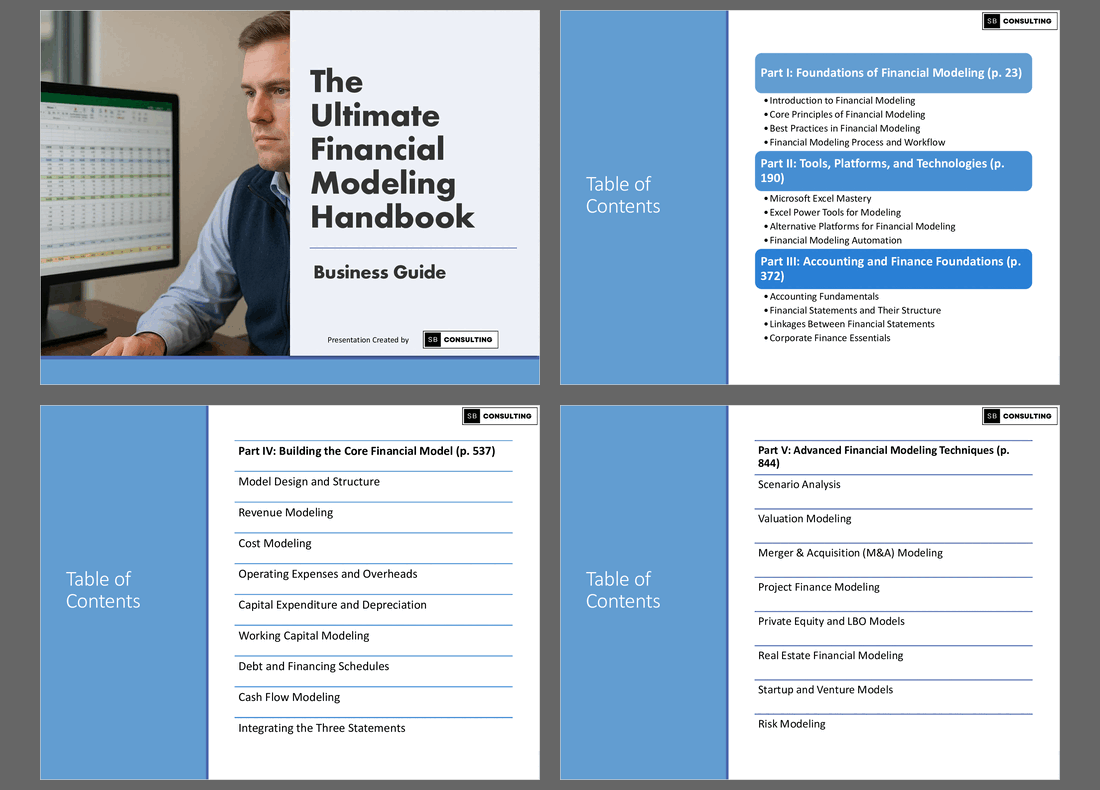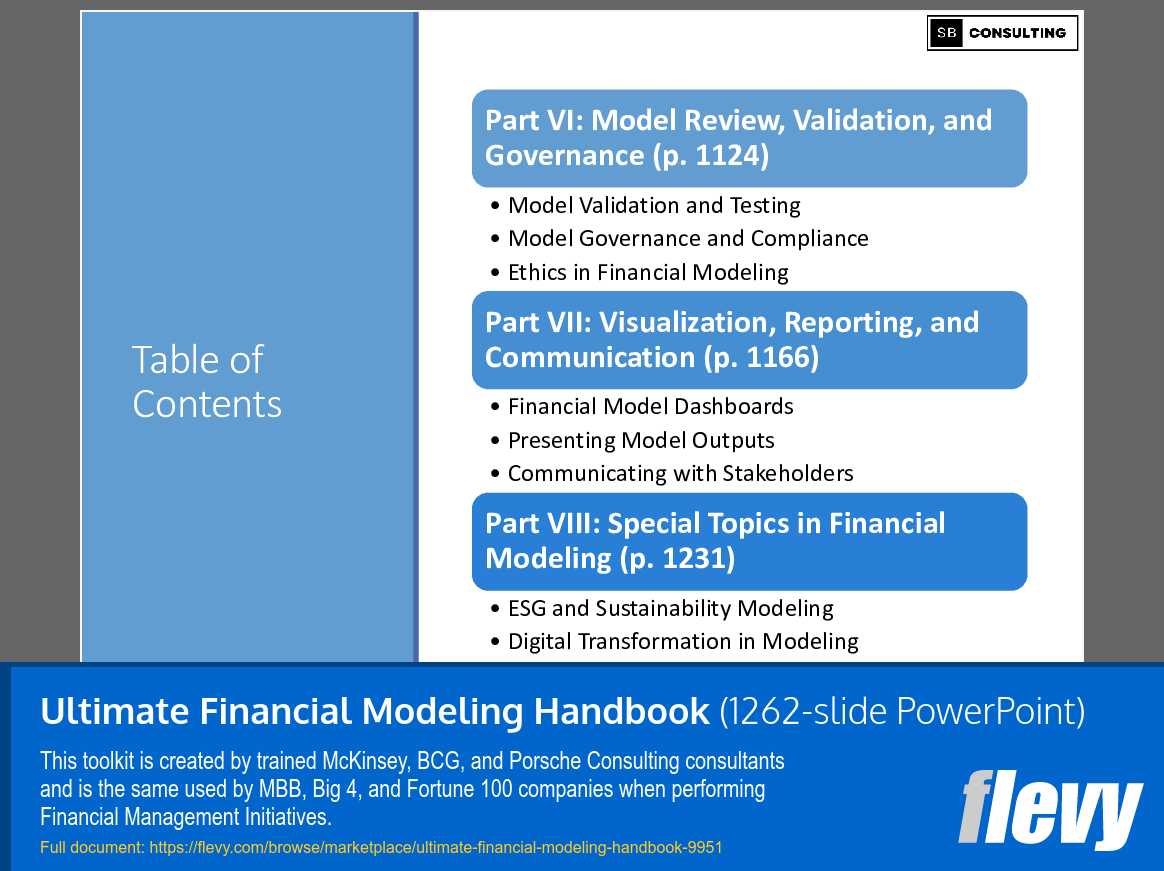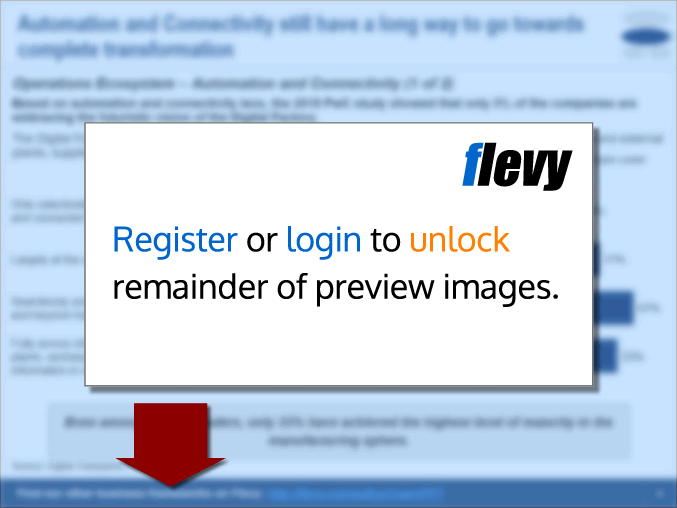Ultimate Financial Modeling Handbook (PowerPoint PPTX Slide Deck)
PowerPoint (PPTX) 1,262 Slides
BENEFITS OF THIS POWERPOINT DOCUMENT
- Delivers step-by-step guidance to build accurate and flexible financial models for any business scenario.
- Equips professionals with practical tools to perform advanced valuation, risk assessment, and scenario planning confidently.
- Enables you to design comprehensive financial forecasts and dashboards that drive strategic decision-making.
FINANCIAL MODELING PPT DESCRIPTION
Curated by McKinsey-trained Executives
🔥 The Ultimate Financial Modeling Handbook (1200+ Slides) – Master Excel, Finance, Valuation & Strategy Like a Pro
📈 Ready to Build Rock-Solid Financial Models That Drive Real Business Decisions?
Introducing the most comprehensive financial modeling training resource ever created – a 1200+ slide PowerPoint deck packed with the frameworks, techniques, tools, and templates used by investment bankers, private equity professionals, startup CFOs, corporate strategists, and financial analysts at the top of their game.
Whether you're looking to break into investment banking, ace your FP&A job, build a DCF from scratch, or automate your Excel models like a machine, this is the only financial modeling handbook you'll ever need.
📚 What Is the Financial Modeling Handbook?
This is not a basic course or a recycled PDF. This is a high-impact, professional-grade handbook, distilled into a PowerPoint format for fast learning, deep retention, and instant integration into your own models.
Built across 8 expertly designed parts, it gives you everything – from Excel mastery and accounting principles to LBOs, DCFs, 3-statement models, valuation modeling, risk analysis, M&A, project finance, ESG modeling, and more.
It's the exact content professionals use in real dealrooms, boardrooms, investor meetings, and C-suite decisions.
🧠 Who Should Get This?
This is your playbook if you are:
• A student preparing for investment banking or private equity interviews
• A finance professional needing to sharpen or refresh your modeling toolkit
• A startup founder building pitch decks, revenue models, or cap tables
• A corporate finance analyst responsible for forecasts, budgets, and board packs
• A consultant or advisor needing credible financial visuals for client delivery
• A trainer or professor looking for a ready-to-deploy financial modeling curriculum
🚀 What You Can Do With This Handbook
• Build bulletproof 3-statement financial models
• Perform sensitivity analysis and scenario planning with precision
• Master DCF, LBO, comps, and precedent transaction analysis
• Integrate financial modeling with BI tools, Python, and automation
• Model startups, real estate, private equity, and project finance
• Communicate insights visually with dashboards and storytelling techniques
• Apply ESG modeling frameworks and sustainability metrics
• Understand financial statement linkages in real-world corporate finance settings
• Automate reports with VBA, Python, and APIs
CONTENT OVERVIEW
Part I: Foundations of Financial Modeling
Introduction to Financial Modeling
• Definition and Purpose of Financial Modeling
• Role in Decision-Making and Strategy
• Types of Financial Models (Overview)
• Common Misconceptions and Pitfalls
Core Principles of Financial Modeling
• Accuracy vs. Practicality
• Transparency and Auditability
• Flexibility and Scalability
• Simplicity and Consistency
• Documentation and Traceability
Best Practices in Financial Modeling
• Golden Rules of Model Building
• Standardization of Layout and Design
• Naming Conventions for Cells, Ranges, and Sheets
• Importance of Modular Design
• Color-Coding and Formatting Standards
Financial Modeling Process and Workflow
• Planning and Scoping a Model
• Defining Objectives and Outputs
• Identifying Key Drivers and Assumptions
• Iterative Development and Testing
• Documentation and Version Control
Part II: Tools, Platforms, and Technologies
Microsoft Excel Mastery
• Excel Interface and Productivity Tips
• Essential Formulas and Functions
• Lookup and Reference Functions
• Logical and Conditional Functions
• Time and Date Functions
• Array and Dynamic Array Functions
• Text Manipulation Functions
• Error Handling Functions
Excel Power Tools for Modeling
• Power Query for Data Extraction and Transformation
• Power Pivot for Data Modeling
• Data Tables and What-If Analysis
• Scenario Manager and Goal Seek
• Solver for Optimization
Alternative Platforms for Financial Modeling
• Google Sheets for Collaboration
• Python and R for Advanced Analytics
• MATLAB for Quantitative Finance
• SQL for Data Handling and Integration
• BI Tools (Tableau, Power BI) for Model Visualization
Financial Modeling Automation
• VBA and Macros in Excel
• Python Automation for Finance
• Integration of APIs for Real-Time Data
• Automating Reports and Dashboards
• Robotic Process Automation (RPA) Applications
Part III: Accounting and Finance Foundations
Accounting Fundamentals
• The Accounting Equation
• Double-Entry Bookkeeping
• Accrual vs. Cash Accounting
• Key Accounting Standards (IFRS, GAAP)
Financial Statements and Their Structure
• Income Statement
• Balance Sheet
• Cash Flow Statement
• Statement of Changes in Equity
• Notes to Financial Statements
Linkages Between Financial Statements
• Net Income to Retained Earnings
• Depreciation and Amortization Flow
• Working Capital Adjustments
• Capital Expenditures and Depreciation
• Debt and Interest Expense
Corporate Finance Essentials
• Time Value of Money
• Cost of Capital (WACC)
• Capital Structure Basics
• Dividend Policies and Payout Ratios
• Valuation Concepts and Multiples
Part IV: Building the Core Financial Model
Model Design and Structure
• Input Sheets and Assumption Pages
• Calculation Sheets
• Output and Summary Sheets
• Separation of Hardcodes and Formulas
• Structuring a Professional Model Layout
Revenue Modeling
• Top-Down vs. Bottom-Up Approaches
• Sales Forecasting Techniques
• Market Size and Market Share Analysis
• Price-Volume Mix Analysis
• Recurring vs. Non-Recurring Revenue
Cost Modeling
• Fixed vs. Variable Costs
• Direct vs. Indirect Costs
• Cost Drivers and Allocation Methods
• Break-Even Analysis
• Operating Leverage Analysis
Operating Expenses and Overheads
• SG&A Expense Forecasting
• R&D and Marketing Costs
• Personnel and Payroll Modeling
• Inflation and Indexation Adjustments
Capital Expenditure and Depreciation
• CapEx Planning and Forecasting
• Asset Lives and Residual Values
• Straight-Line vs. Accelerated Depreciation
• Maintenance vs. Growth CapEx
Working Capital Modeling
• Accounts Receivable Days
• Inventory Days and Turnover
• Accounts Payable Days
• Cash Conversion Cycle
Debt and Financing Schedules
• Debt Structures (Term Loans, Revolvers, Bonds)
• Principal Repayment Schedules
• Interest Expense Calculations
• Covenants and Triggers
• Equity Financing and Dilution
Cash Flow Modeling
• Direct vs. Indirect Cash Flow Forecasting
• Free Cash Flow Calculations
• Levered vs. Unlevered Cash Flow
• Operating, Investing, and Financing Activities
Integrating the Three Statements
• Linking Net Income to Cash Flow
• Handling Depreciation and Non-Cash Items
• Balancing the Balance Sheet
• Iterative Checks and Balancing Mechanisms
Part V: Advanced Financial Modeling Techniques
Scenario Analysis
• Base, Bull, and Bear Cases
• Sensitivity Analysis on Key Drivers
• Tornado and Spider Charts
• Monte Carlo Simulation
Valuation Modeling
• Discounted Cash Flow (DCF) Modeling
• Comparable Company Analysis (Comps)
• Precedent Transactions Analysis
• Leveraged Buyout (LBO) Modeling
• Venture Capital and Startup Valuation
Merger & Acquisition (M&A) Modeling
• Accretion/Dilution Analysis
• Synergy Identification and Valuation
• Purchase Price Allocation
• Goodwill and Intangibles
• Merger Integration Scenarios
Project Finance Modeling
• SPV Structures and Risk Allocation
• Construction vs. Operation Phase Modeling
• Debt Sculpting and Repayment Structures
• DSCR, LLCR, and PLCR Metrics
• Equity IRR and Investor Returns
Private Equity and LBO Models
• Capital Structure Optimization
• Debt Tranches and Interest Waterfalls
• Management Buyouts
• Exit Scenarios and Multiple Expansion
• Equity Bridge Analysis
Real Estate Financial Modeling
• Development Models
• Rental Income Forecasting
• Cap Rate and NOI Analysis
• Construction Loans and Financing
• Exit and Disposition Strategies
Startup and Venture Models
• SaaS Metrics (ARR, MRR, CAC, LTV)
• Burn Rate and Runway Analysis
• Convertible Notes and SAFE Instruments
• Dilution and Cap Table Modeling
• Exit and IPO Scenarios
Risk Modeling
• Credit Risk Models
• Market Risk Simulations
• Liquidity Risk Forecasting
• Operational Risk Quantification
• Stress Testing and Regulatory Scenarios
Part VI: Model Review, Validation, and Governance
Model Validation and Testing
• Common Sources of Errors
• Stress-Testing Assumptions
• Back-Testing Against Historical Data
• Circularity and Iteration Control
• Error-Checking Tools and Techniques
Model Governance and Compliance
• Internal Controls and Audit Trails
• Regulatory Requirements (Basel, SOX, IFRS)
• Model Risk Management Frameworks
• Documentation Standards
• Model Approval and Review Processes
Part VII: Visualization, Reporting, and Communication
Financial Model Dashboards
• Designing Effective Dashboards
• Key Financial Metrics and KPIs
• Visual Storytelling with Data
• Dynamic Charts and Interactive Elements
Presenting Model Outputs
• Executive Summaries and One-Page Overviews
• Board-Ready Presentations
• Investor Pitch Integration
• Storytelling with Numbers
Communicating with Stakeholders
• Tailoring Outputs for Different Audiences
• Explaining Assumptions Clearly
• Handling Challenges and Objections
• Delivering Insights, Not Just Numbers
Part VIII: Special Topics in Financial Modeling
ESG and Sustainability Modeling
• Carbon Footprint Forecasting
• Renewable Energy Project Models
• ESG Risk and Opportunity Assessment
• Sustainable Financing Structures
Digital Transformation in Modeling
• Cloud-Based Modeling Tools
• AI-Powered Forecasting
• Big Data Integration
• Predictive and Prescriptive Modeling
⚡️ Get the Handbook Now – And Build Financial Models Like a Pro
You can spend months cobbling together free YouTube videos and outdated spreadsheets...
Or you can download one resource that has it all – built by professionals, for professionals.
👉 Get instant access to the Financial Modeling Handbook – 1200+ Slides
Start building better models today.
Key Words:
Strategy & Transformation, Growth Strategy, Strategic Planning, Strategy Frameworks, Innovation Management, Pricing Strategy, Core Competencies, Strategy Development, Business Transformation, Marketing Plan Development, Product Strategy, Breakout Strategy, Competitive Advantage, Mission, Vision, Values, Strategy Deployment & Execution, Innovation, Vision Statement, Core Competencies Analysis, Corporate Strategy, Product Launch Strategy, BMI, Blue Ocean Strategy, Breakthrough Strategy, Business Model Innovation, Business Strategy Example, Corporate Transformation, Critical Success Factors, Customer Segmentation, Customer Value Proposition, Distinctive Capabilities, Enterprise Performance Management, KPI, Key Performance Indicators, Market Analysis, Market Entry Example, Market Entry Plan, Market Intelligence, Market Research, Market Segmentation, Market Sizing, Marketing, Michael Porter's Value Chain, Organizational Transformation, Performance Management, Performance Measurement, Platform Strategy, Product Go-to-Market Strategy, Reorganization, Restructuring, SWOT, SWOT Analysis, Service 4.0, Service Strategy, Service Transformation, Strategic Analysis, Strategic Plan Example, Strategy Deployment, Strategy Execution, Strategy Frameworks Compilation, Strategy Methodologies, Strategy Report Example, Value Chain, Value Chain Analysis, Value Innovation, Value Proposition, Vision Statement, Corporate Strategy, Business Development, Busienss plan pdf, business plan, PDF, Biusiness Plan DOC, Bisiness Plan Template, PPT, Market strategy playbook, strategic market planning, competitive analysis tools, market segmentation frameworks, growth strategy templates, product positioning strategy, market execution toolkit, strategic alignment playbook, KPI and OKR frameworks, business growth strategy guide, cross-functional strategy templates, market risk management, market strategy PowerPoint dec, guide, ebook, e-book ,McKinsey Change Playbook, Organizational change management toolkit, Change management frameworks 2025, Influence model for change, Change leadership strategies, Behavioral change in organizations, Change management PowerPoint templates, Transformational leadership in change, supply chain KPIs, supply chain KPI toolkit, supply chain PowerPoint template, logistics KPIs, procurement KPIs, inventory management KPIs, supply chain performance metrics, manufacturing KPIs, supply chain dashboard, supply chain strategy KPIs, reverse logistics KPIs, sustainability KPIs in supply chain, financial supply chain KPIs, warehouse KPIs, digital supply chain KPIs, 1200 KPIs, supply chain scorecard, KPI examples, supply chain templates
NOTE: Our digital products are sold on an "as is" basis, making returns and refunds unavailable post-download. Please preview and inquire before purchasing. Please contact us before purchasing if you have any questions! This policy aligns with the standard Flevy Terms of Usage.
Got a question about the product? Email us at support@flevy.com or ask the author directly by using the "Ask the Author a Question" form. If you cannot view the preview above this document description, go here to view the large preview instead.
Source: Best Practices in Financial Modeling PowerPoint Slides: Ultimate Financial Modeling Handbook PowerPoint (PPTX) Presentation Slide Deck, SB Consulting









